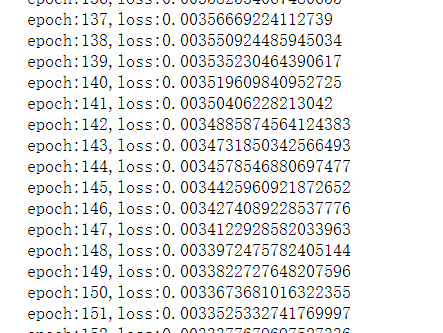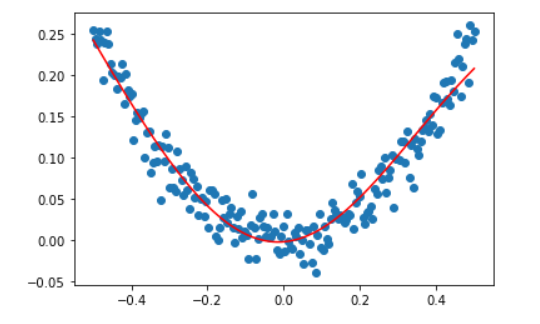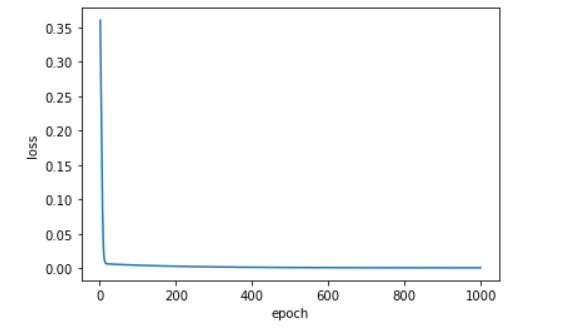TensorFlow实现线性回归
导入依赖包
import tensorflow as tf
import numpy as np
import matplotlib.pyplot as plt
使用numpy随机生成训练数据
通过随机生成的x求出对应的y值,可以自己指定求出y值的方法,主要是使x和y有对应的关系
# 使用mumpy生成200个随机点
x_data = np.linspace(-0.5, 0.5, 200)[:, np.newaxis] # 使得维度为[200,1]
noise = np.random.normal(0, 0.02, x_data.shape) # 维度为[200, 1]高斯分布的数据
y_data = np.square(x_data) + noise
构建我们的网络
# 定义权重和偏置第一层
w1 = tf.Variable(tf.random.normal([1, 10],dtype=x_data.dtype))
b1 = tf.Variable(tf.zeros([1, 10], dtype=x_data.dtype))
# 定义输出
w2 = tf.Variable(tf.random.normal([10, 1], dtype=x_data.dtype))
b2 = tf.Variable(tf.zeros([1, 1], dtype=x_data.dtype))
定义超参数
可以试着改变一下超参数,对比不同的参数训练的结果是什么样的
# 定义超参数
epochs = 1000 # 训练次数
lr = 0.1
train_loss_results = [] # 训练损失结果列表,用来画图展示
开始训练
for epoch in range(epochs):
with tf.GradientTape() as tape: # 记录梯度信息
y1 = tf.matmul(x_data, w1) + b1
l1 = tf.nn.tanh(y1) # 使用tanh激活函数,使得结果都为正数
y2 = tf.matmul(l1, w2) + b2
l2 = tf.nn.tanh(y2) # 使用tanh激活函数
# 使用均方误差求损失值
loss = tf.reduce_mean(tf.square(y_data - l2))
# 计算梯度下降的方向
grads = tape.gradient(loss, [w1, b1, w2, b2])
w1.assign_sub(lr * grads[0])
b1.assign_sub(lr * grads[1])
w2.assign_sub(lr * grads[2])
b2.assign_sub(lr * grads[3])
print(f"epoch:{epoch},loss:{loss}")
train_loss_results.append(loss) # 记录每次的loss

通过训练的权值,求出y_pred
y_pred = tf.matmul(x_data, w1) + b1
l1 = tf.nn.tanh(y_pred)
y_pred = tf.matmul(l1, w2) + b2
y_pred = tf.nn.tanh(y_pred)
画图查看训练结果
plt.scatter(x_data, y_data)
plt.plot(x_data, y_pred, c='r')
plt.show()

查看loss
x_epoch = np.arange(1, epochs+1)
plt.plot(x_epoch, train_loss_results)
plt.xlabel('epoch')
plt.ylabel('loss')
plt.show()





【推荐】国内首个AI IDE,深度理解中文开发场景,立即下载体验Trae
【推荐】编程新体验,更懂你的AI,立即体验豆包MarsCode编程助手
【推荐】抖音旗下AI助手豆包,你的智能百科全书,全免费不限次数
【推荐】轻量又高性能的 SSH 工具 IShell:AI 加持,快人一步
· 如何编写易于单元测试的代码
· 10年+ .NET Coder 心语,封装的思维:从隐藏、稳定开始理解其本质意义
· .NET Core 中如何实现缓存的预热?
· 从 HTTP 原因短语缺失研究 HTTP/2 和 HTTP/3 的设计差异
· AI与.NET技术实操系列:向量存储与相似性搜索在 .NET 中的实现
· 10年+ .NET Coder 心语 ── 封装的思维:从隐藏、稳定开始理解其本质意义
· 地球OL攻略 —— 某应届生求职总结
· 周边上新:园子的第一款马克杯温暖上架
· Open-Sora 2.0 重磅开源!
· 提示词工程——AI应用必不可少的技术